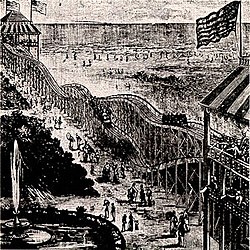Switchback railway
| Switchback Railway | |
|---|---|

The original Switchback Railway at Coney Island
|
|
| Coney Island | |
| Park section | Coney Island Cyclone Site |
| Status | Removed |
| Opening date | June 16, 1884 |
| Closing date | Unknown |
| General statistics | |
| Type | Wood |
| Manufacturer | LaMarcus Adna Thompson |
| Designer | LaMarcus Adna Thompson |
| Model | Lift Packed |
| Track layout | Gravity pulled coaster |
| Lift/launch system | gravity |
| Height | 50 ft (15 m) |
| Drop | 43 ft (13 m) |
| Length | 600 ft (180 m) |
| Speed | 6 mph (9.7 km/h) |
| Duration | 1:00 |
| Max vertical angle | 30° |
| Capacity | 1600 riders per hour |
| G-force | 2.9 |
|
Switchback Railway at RCDB Pictures of Switchback Railway at RCDB |
|
The original Switchback Railway at Coney Island was the first roller coaster designed as an amusement ride in America. It was designed by LaMarcus Adna Thompson in 1881 and constructed in 1884. It appears Thompson based his design, at least in part, on the Mauch Chunk Switchback Railway which was a coal-mining train that had started carrying passengers as a thrill ride in 1827.
For five cents, riders would climb a tower to board the large bench-like car and were pushed off to coast 600 ft (183 m) down the track to another tower. The car went just over 6 mph (9.7 km/h). At the top of the other tower the vehicle was switched to a return track or "switched back" (hence the name).
This track design was soon replaced with an oval complete-circuit ride designed by Charles Alcoke and called the Serpentine Railway. In 1885 Phillip Hinkle developed a lift system which appeared in his ride called Gravity Pleasure. The Gravity Pleasure also featured cars in which the passengers could face forward instead of in the awkward bench-like seats of the first two roller coasters.
Not to be outdone, in 1886 LaMarcus Adna Thompson patented his design of coasters that included dark tunnels with painted scenery. Thompson built many more roller coasters across the country which were called "The L.A. Thompson Scenic Railway". Some of these operated until 1954.
Many of these early coasters were torn down and replaced by larger ones, and soon most roller coasters built before the 1930s had been demolished. But modern roller coaster companies are now resurrecting old "woodies" and building what they call "hybrid" roller coasters, which combine the safety and sturdiness of steel structures with the classic feel of wooden tracks.
There was also a switchback railway at the Melbourne Centennial Exhibition in 1888.
...
Wikipedia
